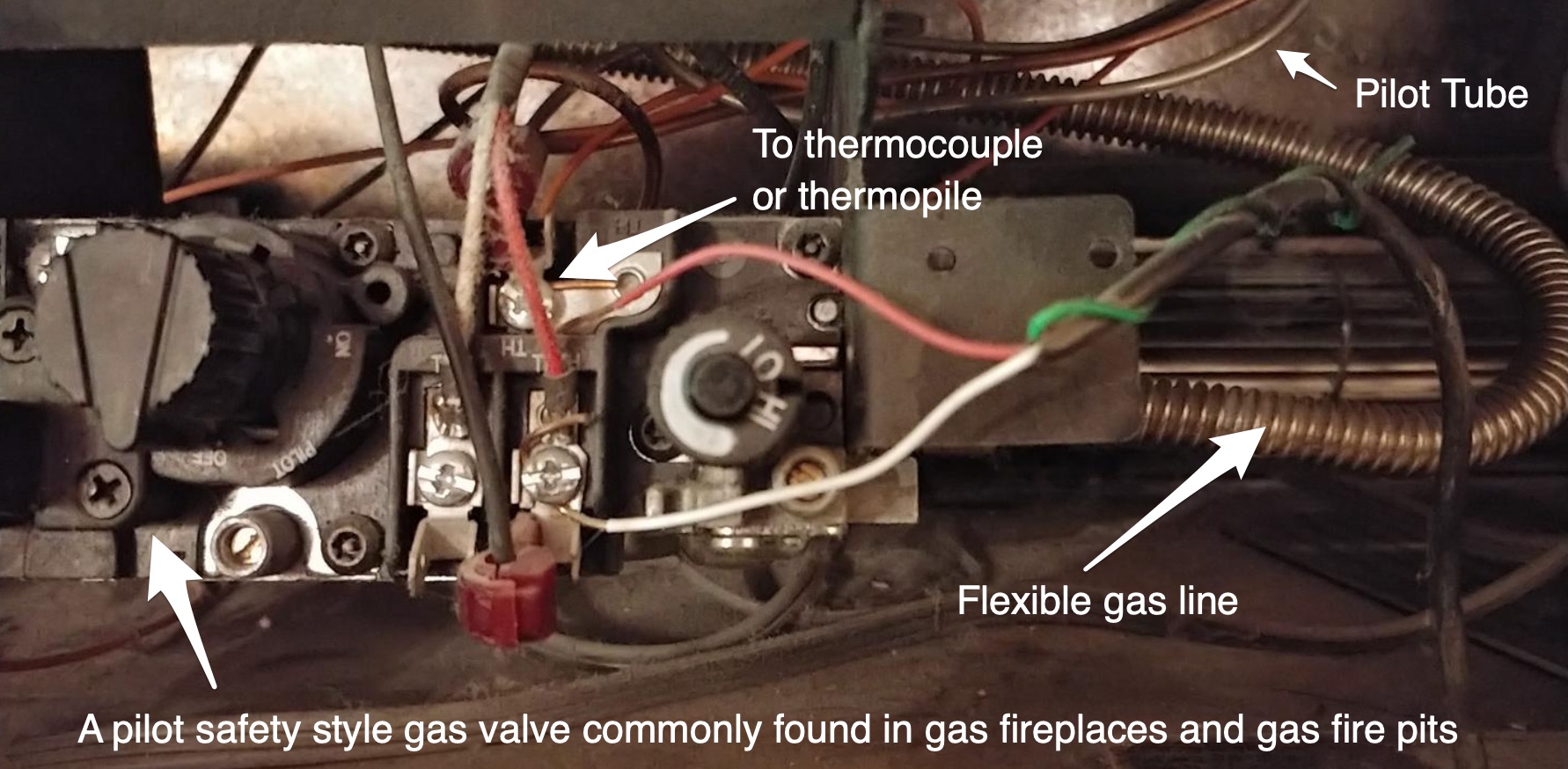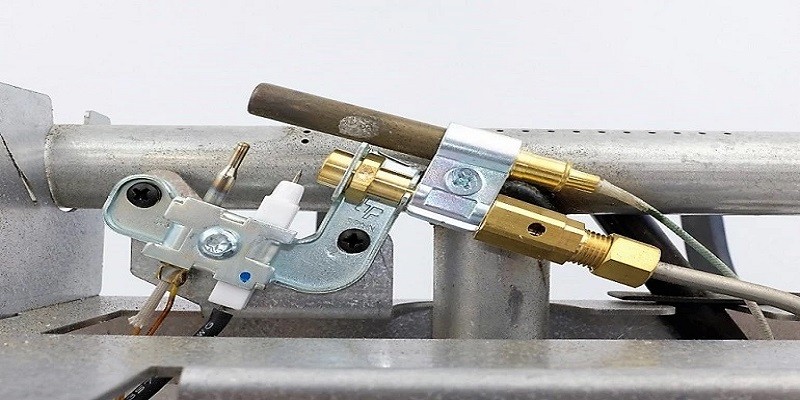Last Updated on September 12, 2023
To clean the thermocouple on a gas fireplace, carefully remove any debris, gently wipe the sensor with a soft cloth, and use a small brush to remove stubborn dirt. Additionally, use compressed air to blow away any remaining particles, then reassemble the components and test the fireplace.
One important aspect of maintaining a gas fireplace is keeping the thermocouple clean. The thermocouple is a crucial component that ensures the safe operation of the fireplace by detecting whether the pilot light is on or off. Over time, the thermocouple can become dirty or covered in soot, which may affect its performance.
Cleaning the thermocouple is a simple and essential task that can help keep the fireplace functioning properly. We will provide a step-by-step guide on how to clean the thermocouple on a gas fireplace, ensuring its efficiency and safety.
The Thermocouple On A Gas Fireplace
Understanding how to clean the thermocouple on a gas fireplace is essential for maintaining its functionality. Regular cleaning ensures proper heat output and prevents potential issues with ignition. Follow these steps to keep the thermocouple clean and your gas fireplace in optimal condition.
In order to properly clean the thermocouple on a gas fireplace, it is important to first understand what a thermocouple is and its significance in the functioning of the fireplace.
What Is A Thermocouple?
- A thermocouple is a safety device that is crucial for gas appliances, including gas fireplaces.
- It is a small metal sensor that is capable of detecting whether the pilot light is on or off.
- Essentially, the thermocouple acts as a fail-safe mechanism by shutting off the gas supply if the pilot light goes out.
Why Is The Thermocouple Important For A Gas Fireplace?
- The thermocouple plays a vital role in maintaining the safety of a gas fireplace.
- By sensing the presence of the pilot light, it ensures that the gas supply is only open when there is a flame.
- This prevents the risk of gas leaks, which can lead to dangerous situations.
- Without a functioning thermocouple, a gas fireplace may not operate properly or safely.
How Does The Thermocouple Work?
- The thermocouple functions based on the principle of thermal-electrical conversion.
- It consists of two dissimilar metals that are connected together.
- One end of the thermocouple is exposed to the pilot light flame, while the other end is connected to the gas valve.
- When the pilot light is on, the heat from the flame generates a small electrical current in the thermocouple.
- This electrical current is what keeps the gas valve open, allowing gas to flow and sustain the flame.
- If the pilot light goes out, the thermocouple quickly cools down, interrupting the electrical current.
- As a result, the gas valve automatically shuts off, preventing any gas from escaping into the space.
- This safety feature ensures that the fireplace will not continue to release gas if the pilot light is extinguished.
Understanding the thermocouple on a gas fireplace is crucial when it comes to maintaining the safety and proper operation of the appliance. Now that we know what a thermocouple is, its importance, and how it works, we can move on to learning how to clean it effectively.
By following the correct cleaning procedures, you can ensure that your thermocouple remains in good condition, allowing your gas fireplace to function reliably and safely.

Credit: airconditioningarizona.com
Signs That Indicate A Dirty Thermocouple
A dirty thermocouple can show signs such as a weak flame, difficulty in igniting the gas fireplace, or constant shutdowns. To clean the thermocouple on a gas fireplace, turn off the gas supply, remove the thermocouple, and gently clean it with a soft brush or sandpaper.
- Delayed or failed ignition:
If you notice that your gas fireplace is taking longer than usual to ignite or is not igniting at all, it could be a sign of a dirty thermocouple. The thermocouple is responsible for sensing the pilot light flame and allowing gas to flow to the burner.
When it becomes dirty or covered in debris, it may not detect the flame properly, resulting in delayed or failed ignition.
- Frequent pilot light outage:
A dirty thermocouple can also lead to frequent pilot light outages. The pilot light should remain lit continuously to ensure that the gas fireplace can be ignited when needed. However, if the thermocouple is dirty, it may not receive enough heat from the pilot light to keep the gas valve open.
This can cause the pilot light to go out frequently, leaving you without a working fireplace.
- Unstable flame:
Another sign of a dirty thermocouple is an unstable flame. When the thermocouple is covered in dirt or debris, it may not be able to properly sense the pilot light flame. As a result, the gas flow to the burner may be inconsistent, leading to an unstable flame.
You may notice flickering, sputtering, or a flame that goes out intermittently. This not only affects the aesthetic appeal of your gas fireplace but can also be a safety concern.
The signs that indicate a dirty thermocouple on a gas fireplace include delayed or failed ignition, frequent pilot light outages, and an unstable flame. If you experience any of these issues, it’s crucial to clean your thermocouple to restore proper functionality and ensure a safe and enjoyable fireplace experience.
How To Clean The Thermocouple On A Gas Fireplace
Looking to clean the thermocouple on your gas fireplace? With these simple steps, you can easily maintain and keep your gas fireplace in top shape, ensuring efficient operation and a cozy ambiance in your home.
Gas fireplaces are a convenient and popular choice for many homeowners, providing warmth and ambiance with the flick of a switch. However, like any other appliance, they require regular maintenance to ensure they function properly. One essential component of a gas fireplace is the thermocouple, which helps control the gas flow and ensures safe operation.
Cleaning the thermocouple is a simple task that can significantly improve the performance and longevity of your gas fireplace. In this guide, we will walk you through the step-by-step process of cleaning the thermocouple on a gas fireplace.
Preparing For The Cleaning Process:
Before you begin cleaning the thermocouple on your gas fireplace, it’s crucial to take the necessary preparatory steps. These include:
- Gathering the Necessary Tools:
- Soft cloth or rag
- Needle-nose pliers
- 400-grit sandpaper or a wire brush
- Gas shut-off valve key (if applicable)
- Turning off the Gas Supply:
- Locate the main gas shut-off valve for your fireplace and turn it off to ensure safety during the cleaning process.
Removing The Access Panel:
The access panel on your gas fireplace provides you with access to the internal components, including the thermocouple. To remove the access panel:
- Locate the access panel on your gas fireplace.
- Carefully remove any screws or fasteners securing the panel.
- Set the panel aside in a safe place, ensuring you don’t misplace any parts.
Locating The Thermocouple:
The thermocouple on a gas fireplace is usually located near the pilot light. To locate the thermocouple:
- Look for a small metal rod positioned near the pilot light.
- The thermocouple is connected to the gas valve and is usually gold or copper in color.
- Take note of its position and how it is attached to the gas valve.
Cleaning The Thermocouple Using A Soft Cloth:
Now that you have located the thermocouple, it’s time to clean it to ensure optimal performance. Follow these steps:
- Gently wipe the surface of the thermocouple with a soft cloth to remove any dirt, dust, or debris.
- Avoid using abrasive materials, as they can damage the delicate components of the thermocouple.
Inspecting For Any Corrosion Or Damage:
While cleaning the thermocouple, it’s essential to inspect it for any signs of corrosion or damage. Look for:
- Corrosion: If you notice any greenish or brownish residue on the thermocouple, it may be corroded. In such cases, consider replacing the thermocouple to maintain the safe operation of your gas fireplace.
- Damage: Check the thermocouple for any visible signs of damage, such as cracks or bends. If you find any damage, contact a professional technician for further assistance.
Reassembling The Fireplace:
To complete the cleaning process, reassemble your gas fireplace by following these steps:
- Carefully reattach the access panel, ensuring that all screws or fasteners are securely tightened.
- Turn on the gas supply by using the gas shut-off valve key (if applicable).
- Light the pilot light according to the manufacturer’s instructions.
- Test the gas fireplace to ensure it is functioning correctly.
Regularly cleaning the thermocouple on your gas fireplace is a simple yet vital maintenance task that can improve its efficiency and prevent potential issues. By following the steps outlined in this guide, you can keep your gas fireplace running smoothly and enjoy its cozy warmth for years to come.
Importance Of Regular Thermocouple Maintenance
Regular thermocouple maintenance is essential for the proper functioning of a gas fireplace. To clean the thermocouple, you can use a soft brush or compressed air to remove any dirt or debris that may affect its performance, ensuring a safe and efficient heat source.
Regular maintenance of the thermocouple on your gas fireplace is crucial for several reasons. Here are three key reasons why taking care of your thermocouple is essential:
- Extending the lifespan of the thermocouple: By cleaning and maintaining your thermocouple regularly, you can significantly extend its lifespan. A well-maintained thermocouple is less likely to malfunction or fail, allowing you to enjoy the warmth of your gas fireplace for many years.
- Avoiding costly repairs: Neglecting thermocouple maintenance can lead to issues that require expensive repairs. Regular maintenance helps to prevent problems such as a faulty connection or build-up of dirt and debris, which could potentially result in the need for professional assistance.
- Ensuring the safety of your gas fireplace: The thermocouple plays a critical role in the safety of your gas fireplace. It is responsible for sensing the presence of a flame and shutting off the gas supply if the flame goes out unexpectedly. Regular maintenance helps to ensure that the thermocouple is functioning correctly, providing you with peace of mind and reducing the risk of gas leaks or other dangerous situations.
Proper care and maintenance of your thermocouple will not only prolong its lifespan but also help you avoid costly repairs and ensure the safety of your gas fireplace. By taking the time to clean and inspect your thermocouple regularly, you can enjoy a warm and cozy ambiance without any worries.
Tips For Maintaining A Clean Thermocouple
Maintaining a clean thermocouple is essential for the optimal performance of your gas fireplace. Discover effective tips and techniques to ensure a properly functioning thermocouple for a cozy and safe heating experience.
Maintaining a clean thermocouple is essential for a well-functioning gas fireplace. Over time, dirt, soot, and debris can accumulate on the thermocouple, hindering its ability to detect the pilot flame and causing issues with the fireplace’s operation. To ensure optimal performance and prevent any potential hazards, follow these tips for maintaining a clean thermocouple.
Annual Professional Inspection
Regularly engaging the services of a professional technician to inspect your gas fireplace is crucial. During an annual inspection, the technician will thoroughly clean and evaluate the condition of the thermocouple, ensuring it is free from any debris or corrosion that can affect its performance.
They will also check other vital components of the fireplace, providing peace of mind and ensuring its safe operation throughout the year.
Regularly Cleaning The Thermocouple
In addition to annual professional inspections, it is important to regularly clean your thermocouple yourself. This will help prevent the buildup of dirt, soot, and other residues that can impede its functionality. Follow these steps to clean your thermocouple effectively:
- Turn off the gas supply to the fireplace.
- Locate the thermocouple, which is typically a small rod located near the pilot light.
- Gently remove the thermocouple from its position.
- Use a soft brush or a cloth to wipe away any dirt or debris from the thermocouple surface.
- Ensure that all sides of the thermocouple are thoroughly cleaned.
- Once clean, reinsert the thermocouple into its original position.
- Restore the gas supply and relight the pilot flame.
Regularly cleaning the thermocouple will maintain its sensitivity and accuracy in detecting the pilot flame, ensuring your gas fireplace operates efficiently.
Checking For Any Gas Leaks
Gas leaks are a serious safety concern, so it’s imperative to regularly check for any signs of leakage around your gas fireplace. Look out for the following indicators:
- A strong smell of gas near the fireplace.
- Hissing or sizzling sounds coming from the gas line.
- Visible cracks or damage in the gas line.
If you detect any of these signs, immediately turn off the gas supply to your fireplace and contact a professional technician to assess and repair the issue.
Keeping The Area Around The Fireplace Clean
To ensure a clean and safe environment, it’s important to keep the area around your gas fireplace tidy. Dust, debris, and flammable materials can accumulate near the fireplace, posing a fire hazard.
- Regularly vacuum or sweep the area surrounding the fireplace to remove dust, lint, or other particles.
- Keep flammable materials, such as rugs, curtains, and furniture, at a safe distance from the fireplace.
- Avoid cluttering the fireplace area with any objects that could obstruct ventilation or impede the operation of the fireplace.
By adhering to these tips, you can maintain a clean thermocouple, enhance the safety of your gas fireplace, and ensure its optimal performance for years to come. Regular maintenance and care will not only prolong the lifespan of your fireplace but also provide a cozy and comforting ambiance in your space.
Frequently Asked Questions For How To Clean Thermocouple On Gas Fireplace?
Why Wont The Pilot Light Stay Lit On My Gas Fireplace?
A gas fireplace pilot light may not stay lit due to several possible reasons. Firstly, it could be caused by a dirty or damaged thermocouple, which is a safety device that detects a flame and keeps the gas valve open.
Secondly, a pilot light may go out if the gas valve itself is faulty or if there is a problem with the gas supply. Additionally, a clogged pilot tube or burner ports can disrupt the flow of gas and extinguish the flame.
Other factors, such as a weak gas pressure or a malfunctioning gas regulator, can also prevent the pilot light from staying lit. It is crucial to have a professional inspect and repair the issue to ensure proper functioning and safety.
How Do You Clean The Igniter On A Gas Fireplace?
To clean the igniter on a gas fireplace, follow these steps: 1. Turn off the gas supply and ensure the fireplace is completely cool. 2. Locate the igniter, usually at the bottom or side of the unit. 3. Remove any debris or dust from the igniter using a soft brush or cloth.
4. Inspect the igniter for signs of wear or damage, and replace if necessary. 5. Gently clean the igniter with rubbing alcohol and a cotton swab to remove any residue. 6. Allow the igniter to dry completely before reassembly. 7.
Once dry, reassemble the gas fireplace and restore the gas supply. 8. Test the igniter by turning on the fireplace and checking for a spark. Regular cleaning of the igniter ensures proper ignition and maximizes the efficiency of your gas fireplace.
What Does A Fireplace Thermocouple Look Like?
A fireplace thermocouple is a small, metal sensor located near the pilot light of a gas fireplace. It measures the temperature and helps regulate the flow of gas to the pilot light. The thermocouple is typically made of copper or stainless steel and has a thin, tube-like shape.
It is connected to the gas valve through a small nut and extends into the fireplace. The end of the thermocouple is heated by the pilot light, which generates a voltage. If the pilot light goes out, the voltage decreases, signaling the gas valve to shut off the flow of gas to the fireplace.
This safety feature prevents the buildup of gas and potential fires. Overall, the fireplace thermocouple is a vital component for the safe and efficient operation of a gas fireplace.
Where Is The Thermocouple Located On A Gas Fireplace?
The thermocouple on a gas fireplace is typically located near the pilot light. It senses the heat and generates an electrical current to keep the gas valve open.
Conclusion
Maintaining a clean thermocouple on your gas fireplace is crucial for its efficient functioning. Regularly cleaning this small yet vital component ensures that it accurately detects the pilot light’s heat and keeps the gas flowing smoothly. Cleaning the thermocouple is a simple task that requires minimal effort but offers significant benefits.
Take the time to gather the necessary tools and follow the step-by-step process outlined in this blog post. By using a soft cloth and some compressed air, you can remove any dirt or debris that may have accumulated. Remember to exercise caution and turn off the gas supply before starting.
A clean thermocouple will help prevent common issues, such as a weak or intermittent flame, and ensure that your gas fireplace functions optimally, providing warmth and ambiance for your home.










